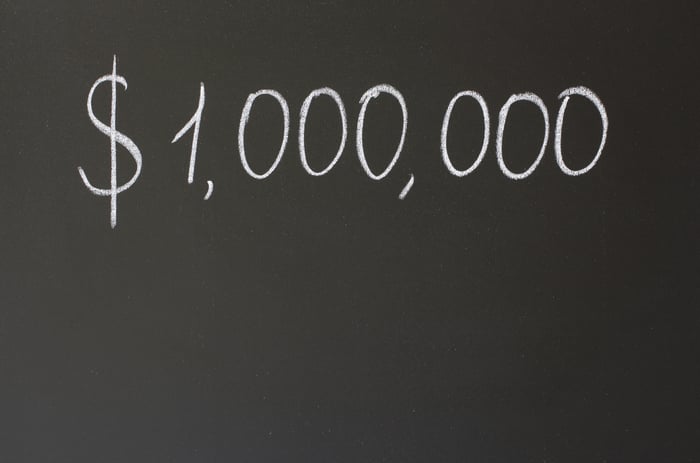If you have a certain savings goal, such as wanting to amass a million dollars by the date you retire, you'd do well to crunch a few numbers to find out just how long it will take to do so at your current savings rate.
Many people do aim for a million dollars, but take some time to determine whether that's really the right goal for you.

Image source: Getty Images.
Do you need to save a million dollars?
Let's start with whether you really need to aim for a million bucks. It's a nice, round number, but it might not be right for you. After all, each of us is in a different situation -- some with pensions, some with significant expected Social Security income, some with little expected income in retirement except for what we provide for ourselves. For best results, spend some time figuring out what you need. (And note that there are ways to boost your income in retirement.)
The "4% rule" can help here. It's flawed but still helpful and says that you can withdraw 4% of your nest egg in your first year of retirement, adjusting future withdrawals for inflation. It assumes a portfolio that's 60% in stocks and 40% in bonds, and it's designed to make your money last through 30 years of retirement.
You can flip it around to help you determine how much you'll need to accumulate in the first place. First, though, you need to know how much annual income you'll want in retirement. Let's say, for example, that you'd like a total annual income of $60,000, and you expect to collect $25,000 from Social Security. That leaves $35,000 in income that you'll need to generate on your own. It would be your first year's withdrawal. So if you assume that $35,000 is 4% of your nest egg, then you can multiply $35,000 by 25 to arrive at how big the nest egg will need to be: $875,000. (Why 25? Because one divided by 0.04 is 25.) In this case, you wouldn't need a full million dollars.

Image source: Getty Images.
Be conservative with your estimates
Whatever end goal you come up with, though, consider upping it a little, as there's a good chance that you'll need more than you expect. For starters, you may be underestimating how much healthcare will cost you. The folks at Fidelity Investments annually estimate how much a 65-year-old couple will spend out of pocket, on average, in retirement on healthcare, and they recently released their latest number: $260,000.
If you're expecting your children to help support you in retirement, the opposite is what often comes to pass. According to a HSBC survey conducted in 2013, about 62% of retirees are providing financial support to at least one family member. Sure, grown kids are supposed to be financially independent, but that's gotten harder and harder in recent years, partly because of student loan debt.
Then there's inflation, which is often overlooked when planning for retirement. Imagine, for example, that you're aiming to amass $875,000 by the time you retire in 20 years, figuring that that sum will be enough to support you. Well, if inflation averages about 3%, its approximate historical average, then that $875,000 will end up having the purchasing power of just $484,000 in today's dollars. You'd need to amass about $1.6 million by retirement in order to end up with the purchasing power of $875,000 today.
On the other hand, you may need a little less in retirement, because as you get older, some of your costs can go down. For one thing, you'll no longer have to buy office attire, which can be pricey. You'll no longer be commuting, either -- so the amount you spend on gas and tolls and car maintenance can decline, too. If you used to buy your lunch most days when you worked, you can reap major savings by preparing most of your own lunches in retirement. And if you've finally paid off your home -- which is a smart thing to do before retiring -- then you won't face mortgage payments.

Image source: Getty Images.
How long will it take to save a million dollars?
Let's just assume for now, though, that your savings goal is a million dollars. How long will it take to accumulate that? Obviously, it will depend on how aggressively you can sock money away, how long those dollars have to grow, and their average growth rate.
* Calculator is for estimation purposes only, and is not financial planning or advice. As with any tool, it is only as accurate as the assumptions it makes and the data it has, and should not be relied on as a substitute for a financial advisor or a tax professional.
Let's run through an example of how to use the calculator. Note that it opens with some default settings. Change your current age and your desired retirement age to the right numbers for you. In the "initial balance or deposit" box, enter your current retirement savings. If you have yet to start socking money away for your future, you'd enter a 0. It assumes that you'll increase your annual savings amounts by 0% annually. Change that if you expect to be socking away more and more. It assumes an average annual growth rate of 8%, too. That's reasonable, because as the calculator notes in a pop-up box that you can see by clicking on the little blue question mark, stocks have averaged annual returns of between 10% and 12% annually over long periods, ignoring the effect of inflation:
|
Avgerage Annual Growth Rate, 1926-2015 |
|
|---|---|
|
Inflation |
2.9% |
|
U.S. Treasury bills |
3.4% |
|
5-year fixed-term investments |
5% |
|
Long-term government bonds |
5.6% |
|
U.S. large-company stocks |
10% |
|
U.S. small-company stocks |
12% |
Data source: Ibbotson, via CalcXML.com.
The calculator also assumes you're in the 25% tax bracket, as many people are -- though tax brackets in the future might be rather different. It assumes an annual inflation rate of 3%, too, which is about average. Once you click "Submit," you'll see the results. The default example shows that a 35-year-old who wants to retire at 65 needs to save $11,933 per year -- or $28,964, adjusted for inflation.
That can be alarming, but remember that you may well not need a million dollars at retirement, and that there are ways to boost your retirement income and maximize Social Security income, too.
Don't leave your future financial security to chance. Plan for your retirement now, and start by estimating how much you'll need to accumulate for the future.




